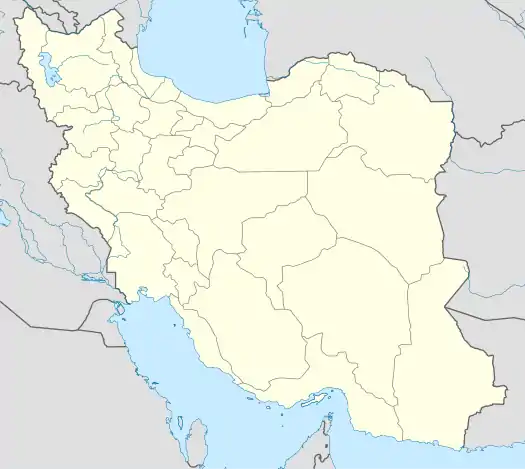Lak (Volk)
Die Lak, Alak oder Lek sind ein lurischer Stamm[1][2][3][4][5][6] oder die südöstliche Gruppe der Kurdenstämme in Kermānschāh, Lorestan, Elam und Hamadan.
 Lak (Volk) (Iran)
|
Ihr Siedlungsgebiet wird auch Lakistan (deutsch Land der Laks) genannt. Laki gilt als Dialekt des Lurischen[7][8][9] oder des Südkurdischen.
Zu den die Sprache der Lak sprechenden Stämmem gehören die Turkaschvand in Luristan.[10][11]
Geschichte
Der Name Lak könnte vom persischen Zahlwort lak (لك) für Hunderttausende stammen und damit die ursprüngliche Anzahl der Lak-Familien bezeichnen.[12] Die Laks sind geschichtlich insofern wichtig, als die Dynastie der Zand-Fürsten, die den Iran im 18. Jh. regierten, lakischen Ursprungs ist. Die Geschichte zeigt, dass die Laks vom Norden kommend in ihr heutiges Siedlungsgebiet einwanderten. Gemäß dem Autor Rabino wurden die Laks auf Befehl von Schah Abbas dort angesiedelt.
Aus den Reihen der Lak gingen zwei iranische Revolutionäre hervor: Yār-Moḥammad Khan Kermānšāhi, der 1910 in Täbris für die Konstitutionalisten kämpfte und 1912 in Kermānschāh in einer Schlacht gegen Prinz Farmanfarma getötet wurde, und Ḵālu Qorbān Harsini, der 1920 ein Kommandeur der Guerillatruppen von Mirza Kutschak Khan war.[13]
Weblinks
- Lak (Volk). In: Ehsan Yarshater (Hrsg.): Encyclopædia Iranica. (englisch, iranicaonline.org – inkl. Literaturangaben).
- Kurdish or Luri?Laki’s disputed identity in the Luristan province of Iran, Erik John Anonby, in: Kurdische Studien 4 + 5 (2004/2005): S. 7–22, ISSN 1617-5417
Einzelnachweise
- ایزدپناه، ح. فرهنگ لکی، مؤسسه فرهنگی جهانگیری، تهران ۱۳۶۷خ، ص ده (مقدمه)
- The Lurs of Iran. Cultural Survival, März 1985, abgerufen am 21. September 2015.
- امان الاهی بهاروند، سکندر. قوم لر. تهران: آتیه، 1393
- E. J. Anonby: Kurdish or Luri? Laki’s Disputed Identity in the Luristan Province of Iran. In: Kurdische Studien, 4/1-2, 2004, S. 5–20.
- S. Amanolahi: Reza Shah and the Lurs: The Impact of the Modern State on Luristan. In: Iran & the Caucasus, 6(1/2), 2002, S. 193–218, JSTOR 4030721
- Erik John Anonby: Update on Luri: How many languages? In: Journal of the Royal Asiatic Society (Third Series), 13, 2003, S. 171-197, doi:10.1017/S1356186303003067.
- William J. Frawley, William Frawley: International Encyclopedia of Linguistics& 4-Volume Set, Volume 1. Oxford University Press, 2003, ISBN 978-0-19-513977-8, S. 310.
- Albrecht Klose: Sprachen der Welt. De Gruyter, 2001, ISBN 978-3-598-11404-5, S. 227.
- B. Grimes (ed.): Luri. In: Ethnologue. 13th edition. Dallas 1996, S. 677. M. Ruhlen: A Guide to the World’s Languages. Stanford 1991, S. 327.
- Frank Hole, Sekandar Amanolahi-Bahanvand: Tribal Pastoralists in Transition. The Baharvand of Luristan, Iran (= Anthropological Papers. Nr. 100). The Museum of Anthropology, Ann Arbor 2021, ISBN 978-0-915703-99-9, S. 179.
- Vgl. auch Nasrollah Kasraian, Ziba Arshi: Our Homeland Iran. Sekké Press, Iran 1990; 10. Auflage ebenda 1998, ISBN 964-6194-91-5, Foto-Nr. 116 (Torkāshvand trib, Luristān).
- Vgl. angegebenen Weblink
- Mohammad Reza Faribors Hamzeh'ee, “LAK TRIBE”, in: Encyclopaedia Iranica Online, © Trustees of Columbia University in the City of New York. Consulted online on 17 January 2022 http://dx.doi.org/10.1163/2330-4804_EIRO_COM_11861